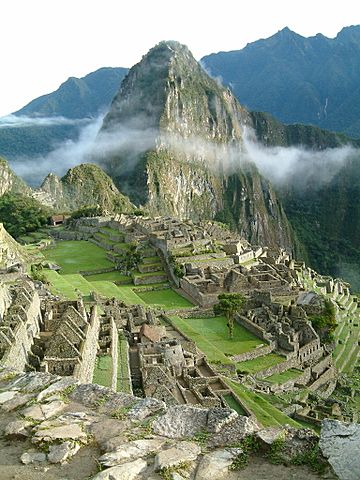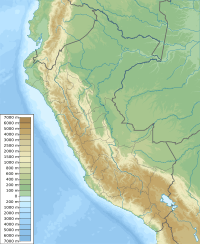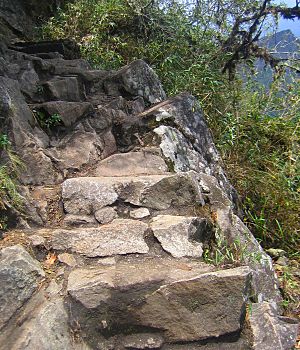Huayna Picchu facts for kids
Quick facts for kids Huayna Picchu |
|
|---|---|

Sunrise over Huayna Picchu towering above the ruins of Machu Picchu
|
|
| Highest point | |
| Elevation | 2,693 m (8,835 ft) |
| Prominence | 260 m (850 ft) |
| Naming | |
| Native name | Error {{native name}}: an IETF language tag as parameter {{{1}}} is required (help) |
| Geography | |
| Parent range | Andes |
Huayna Picchu (also called Wayna Pikchu in the Quechua language) is a famous mountain in Peru. It stands tall over the ancient Inca city of Machu Picchu, which is often called the "lost city of the Incas." The Urubamba River curves around the base of this mountain.
This mountain is located in the Cusco Region, in the Urubamba Province. The ancient people called the Incas built a special trail up the side of Huayna Picchu. They also built temples and terraces right on its top. The highest point of Huayna Picchu is about 2,693 meters (8,835 feet) above sea level. This makes it about 260 meters (850 feet) taller than Machu Picchu itself.
Local guides say that the very top of Huayna Picchu was once home to a high priest and young women who served the Inca people. Every morning, before the sun came up, the high priest and a small group would walk to Machu Picchu. They would signal the start of a new day.
One important place on the mountain is the Temple of the Moon. It is one of the main temples in the Machu Picchu area. This temple is built into the side of the mountain, at a lower height than Machu Picchu. Next to it is the Great Cavern, another sacred temple with amazing stonework. Other important temples in Machu Picchu include the Temple of the Condor, Temple of Three Windows, and the Temple of the Sun.
The name "Huayna Picchu" comes from the Quechua language. Wayna means "young" or "young man." Pikchu means "pyramid," "mountain," or a "peak with a wide base that ends in sharp points." So, Huayna Picchu means "young peak." The official spelling used by the Peruvian Ministry of Culture is Waynapicchu.
Contents
Visiting Huayna Picchu
Huayna Picchu is open to visitors all year round. However, only a limited number of people can hike up the mountain each day. Only 400 visitors are allowed daily to protect the site.
Entrance Times and Trails
Visitors can enter the Huayna Picchu trail during two specific times:
- Between 7:00 AM and 8:00 AM
- Between 10:00 AM and 11:00 AM
The 400 hikers are split evenly, with 200 allowed during each time slot. The path to the top is steep and can be challenging. Some parts are slippery, and there are steel cables to help you climb safely.
There are two main trails to reach the summit:
- The shorter trail takes about 45 to 60 minutes to reach the top.
- The longer trail takes about 3 hours to reach the summit.
Best Time to Visit
Climbing is harder between November and April because it is the rainy season. The path becomes slippery then. The best time to climb is during the dry season, which runs from May to September.
Exploring Beyond the Summit
From the summit, another trail goes down to the Great Cavern and the Temple of the Moon. These are natural caves located on the northern side of the mountain. They are actually lower than where the main trail starts. The path from these caves forms a loop, bringing you back to the main trail around the mountain.
Huayna Picchu in Culture
Huayna Picchu has appeared in movies and TV shows.
- The movie Aguirre, the Wrath of God (1972) was partly filmed on the stone stairway of Huayna Picchu.
- In the Hulu TV series The Path, a main belief of the fictional Meyerism group is that their founder climbed a "ladder of burning light" on top of Huayna Picchu.
See also
 In Spanish: Huayna Picchu para niños
In Spanish: Huayna Picchu para niños





